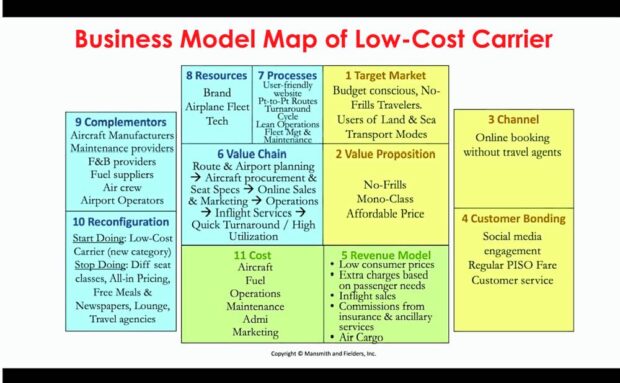Budget airline model: A wide-angle look

IMG_7357
Let’s examine a scenario where superb marketing is coupled with insufficient business model with the entry of budget airlines.
Philippine Airlines (PAL) smartly offered different classes—first class, business and economy—to suit various travelers’ needs. PAL emphasized its sterling reputation for top-tier service and unwavering safety standards. It actively engaged in travel expos, events and rolled out specialized promotions and loyalty programs. Furthermore, PAL nurtured relationships with travel agencies, offering incentives to cultivate customer loyalty and stimulate repeat business.
But the landscape shifted with the emergence of low-cost carriers (LCCs) such as Cebu Pacific Air in the mid-1990s. The allure of budget-friendly fares and enticing deals for popular destinations resonated with budget-conscious travelers.
LCC offering model
1. Target market: Price-conscious, no-frills travelers and users of alternative transportation modes 2. Value proposition: No-frills, mono-class (economy class without free lunch or snacks) affordable price
3. Channel: Online booking without travel agents
4. Customer bonding strategy: Regular Piso fare promotions to make flying accessible to everyone, social media engagement, customer service
5. Revenue model: Low consumer prices if booked early, but extra charges apply based on passenger needs. Generate additional revenue from air cargo business and inflight sales, commissions from selling ancillary services like insurance
LCC operating model
6. Value chain: Route and airport planning, aircraft procurement and seat specs, online sales and marketing, operations, inflight services, then quick turnaround/high utilization7. Key processes: User-friendly website, point-to-point routes, efficient turnaround cycle, simplified and lean operations, fleet management and maintenance
8. Key resources: Brand, fleet of airplanes and tech
9. Key complementors: Aircraft manufacturers, maintenance provider, food and beverage provider, fuel suppliers, air crew and airport operators
10. Reconfiguration for innovation: Start doing LCC. Stop doing different seat classes, all-in pricing, free meals and newspapers, lounge and travel agencies.11. Costs: Oil, maintenance, administration and marketing cost.
In the case of Cebu Pacific Air, a low-cost operation was necessary to sustain low prices. Initially, they used the same plane type, mono class and removed many traditional services. Instead of market segmentation, they focused on desegmentation based on a single commonality – low price. Unlike the traditional offer of “more for less” marketing approaches, they challenged the norm by offering a “less for less” business model, driving the market to adopt a new category with new expectations.
While PAL had marketing efforts in place, it had to reevaluate its business model to stay competitive. It implemented cost-cutting measures and acquired Air Philippines, renaming it PAL Express, to counter loss of market share on local routes. The initial marketing efforts fell short due to different assumptions and business model design. For example, there was a time when PAL made meals optional but as its passengers had been used to automatic meal inclusion on all flights, this caused much customer dissatisfaction.
What is a business model?
It brings a business idea to life, demonstrating how a firm intends to create, deliver and capture value for its target market and the firm. The Mansmith Business Model Map has 11 building blocks that offer a comprehensive framework for designing and analyzing a business model. This framework aids decision-making, strategic planning and effective execution, subdivided into the offering model and the operating model.
Here’s a breakdown of each building block using the LCC example.
A. Offering model
1. Target market: Identify intended beneficiaries of a firm’s products or services.
2. Value proposition: Specify the relevant and unique benefit that consumer gets from buying or owning the firm’s products or services.
3. Channel: Describe the distribution system where products or services will be made available to the customers.4. Customer bonding strategy: The relationship as well as the solution that will be established with buyers and end users; aims to communicate, build trial and maintain strong customer relationships.
5. Revenue model: Define the framework how a firm will be compensated for providing its value proposition to support its intended profit.
B. Operating model
6. Value chain: This represents the strategic linkage of the extended supply chain for the firm to provide value proposition to the customers for competitive advantage.
7. Key processes: The critical repetitive activities that are routinized by the firm to deliver the value to the customers and to the firm in a sustainable way.8. Key resources: The most important hard and soft assets deployed by the firm to carry out its value proposition for the customers.
9. Complementors: People or groups who will help, both directly and indirectly to enhance the value proposition.
10. Reconfiguration for innovation: Emphasize the rearrangement of resources, processes, activities or offering that can help enhance profit goal.11. Cost: Refer to the monetary consequences of the means to carry out the value proposition.
Two building blocks are emphasized in the Mansmith Business Model Map for a more complete view. These are value chain (which enables the value proposition) and reconfiguration for innovation (from challenging industry’s assumptions) to ensure comprehensive business model design. These two underscore aspects essential for both short-term and long-term success and competitiveness in the evolving business landscape.
By considering all 11 building blocks, businesses gain a holistic understanding of their target market, value proposition, channels, customer relationships, revenue generation, value chain, processes, resources, complementors, intended innovation and cost structure.
By examining this case, one uncovers a blueprint for innovative models to think differently, see things differently and do things differently.
—CONTRIBUTED
The 3rd Business Model Forum is set on Sept. 15. To attend the weeklong celebration of the Business Model Week for free, register at www.continuum-edu.com.
Josiah Go is chair/chief innovation strategist of Mansmith and Fielders Inc. and author of 55-video Business Model Course. He will host another “Business Model Innovation for Corporate Transformation” seminar tailored for time-starved executives on Oct. 3 to 5. Email info@mansmith.net.
